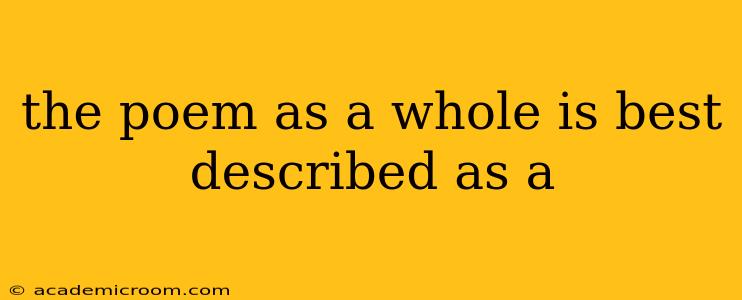The Poem as a Whole: A Comprehensive Guide to Poetic Analysis
Analyzing a poem goes beyond simply reading the words; it's about understanding the author's intent, the techniques employed, and the overall effect on the reader. The question, "The poem as a whole is best described as a..." requires a nuanced response, depending entirely on the specific poem in question. However, we can explore several common descriptors and the elements that contribute to each classification.
This guide will help you analyze a poem and determine the most fitting description. We'll explore various poetic forms and styles, addressing common questions that arise during analysis.
What are some common ways to describe a poem as a whole?
A poem's overall description can encompass many aspects: its form, its tone, its theme, and its style. Some common descriptors include:
- Narrative Poem: Tells a story, often with characters, setting, plot, and conflict. Think of epic poems like The Odyssey or shorter ballads.
- Lyrical Poem: Expresses personal emotions or reflections. These poems often focus on feelings and imagery, using musicality and rhythm to create a mood. Sonnets and odes are examples of lyrical forms.
- Dramatic Poem: Uses dramatic elements such as dialogue, monologue, and action to convey a story or explore a theme. Dramatic monologues, like Robert Browning's "My Last Duchess," are a prime example.
- Didactic Poem: Aims to teach a lesson or convey moral instruction. These poems explicitly impart knowledge or wisdom.
- Epic Poem: A long narrative poem, often celebrating heroic deeds or a nation's history.
- Ode: A formal, often lyrical poem expressing praise or admiration for a person, object, or event.
- Sonnet: A 14-line poem with a specific rhyme scheme and meter (usually iambic pentameter).
- Free Verse: Poetry without a regular rhyme scheme or metrical pattern. It often relies on rhythm and imagery to create its effect.
How do I determine the best descriptor for a specific poem?
Consider the following elements:
- Structure and Form: Does it follow a specific rhyme scheme or meter? Is it a sonnet, haiku, free verse, etc.? The formal structure significantly impacts the overall feel.
- Theme: What is the central idea or message of the poem? Is it about love, loss, nature, social justice, etc.? The theme is crucial in understanding its essence.
- Tone: What is the overall mood or feeling of the poem? Is it happy, sad, angry, reflective, humorous, etc.? Tone is conveyed through word choice, imagery, and rhythm.
- Imagery and Language: What kind of images and language does the poem use? Is it figurative, literal, symbolic? The language style heavily influences the overall experience.
- Purpose: What is the poet trying to achieve with the poem? Is it to tell a story, express emotion, make a statement, teach a lesson, etc.? The author's intent shapes the poem's impact.
What if the poem blends different styles?
Many poems blend elements of different styles. For instance, a narrative poem might also have lyrical passages expressing a character's emotions. In such cases, consider the dominant element or the overall effect the poem creates. The best descriptor will be the one that most accurately reflects the poem's primary characteristics and impact.
By carefully analyzing these aspects, you can confidently identify the most suitable and accurate description of a poem as a whole. Remember to support your conclusion with specific textual evidence from the poem itself.
